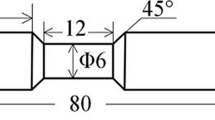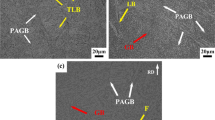Abstract
Microstructure evolution and impact toughness of simulated heat affected zone (HAZ) in low carbon steel have been investigated in this study. Thermal simulator was used to simulate microstructure evolution in HAZ with heat input of 10 – 100 kJ / cm welding thermal cycle. Results indicated that microstructure of HAZ mainly consisted of acicular ferrite (AF) inside grain and high volume fraction of grain boundaries ferrite (GBF) at prior austenite boundaries; the size of GBF and effective grain size increased with increasing heat input. Excellent impact toughness (more than 150 J at −40 °C) was obtained in HAZ with heat input less than 50 kJ / cm. When heat input was 100 kJ / cm, the impact toughness of HAZ decreased to 18 J because of the presence of large M-A constituent with lath-form in HAZ, assisting the micro-crack initiation and decreasing the crack initiation energy seriously. Effect of inclusions on acicular ferrite transformation in HAZ was also discussed.
Similar content being viewed by others
References
Shim J H, Cho Y W, Chung S H, et al. Nucleation of Intragranular Ferrite at Ti2O3 Particle in Low Carbon Steel[J]. Acta. Mater., 1999, 47: 2751–2760
Guo A M, Li S R, Guo J, et al. Effect of Zirconium Addition on the Impact Toughness of the Heat Affected Zone in a High Strength Low Alloy Pipeline Steel[J]. Mater. Charact., 2008, 59: 134–139
Lee J L, Pan Y T. The Formation of Intragranular Acicular Ferrite in Simulated Heat Affected Zone[J]. ISIJ. Int., 1995, 35: 1027–1033
Shi M H, Zhang P Y, Wang C, et al. Effect of High Heat Input on Toughness and Microstructure of Coarse Grain Heat Affected Zone in Zr bearing Low Carbon Steel[J]. ISIJ. Int., 2014, 54: 932–937
Lan L Y, Qiu C L, Zhao D W, et al. Microstructural Characteristics and Toughness of the Simulated Coarse Grained Heat Affected Zone of High Strength Low Carbon Bainitic Steel[J]. Mater. SciEng. A, 2011, 529: 192–200
Akselsen O M, Grong O, Solberg J K, et al. Structure-Property Relationships in Intercritical Heat Affected Zone of Low-Carbon Microalloyed Steels[J]. Mater. Sci. Tech., 1987, 3: 649–655
Lee S, Chun B, Kwon D, et al. Correlation of Microstructure and Fracture Properties in Weld Heat-Affected Zones of Thermomechanically Controlled Processed Steels[J]. Metall. Trans. A, 1992, 23: 2803–2816
Davis C L, King J E. Cleavage Initiation in the Intercritically Reheated Coarse-Grained Heat-Affected Zone: Part I. Fractographic Evidence[J]. Metall. Trans. A, 1994, 25: 563–573
Rykalin N. Calculation of Heat Processes in Welding[C]. Mashgiz, Moscow, USSR, 1960
A F G, Flower H M, Lindley T C. Electron Backscattering Diffraction Study of Acicular Ferrite, Bainite, and Martensite Steel Microstructures [J]. Mater. Sci. and Tech., 2000, 16: 26–40
Lambert-Perlade A, Gourgues A F, Pineau A. Austenite to Bainite Phase Transformation in the Heat-Affected Zone of a High Strength Low Alloy Steel [J]. Acta. Mater., 2004, 52: 2337–2348
Lambert A, Garat X, Sturel T, et al. Application of Acoustic Emission to the Study of Cleavage Fracture Mechanism in a HSLA Steel[J]. Scripta. Mater., 2000, 43: 161–166
Shi M H, Zhang P Y, Zhu F X. Toughness and Microstructure of Coarse Grain Heat Affected Zone with High Heat Input Welding in Zrbearing Low Carbon Steel[J]. ISIJ. Int., 2014, 54: 188–192
Bramfitt B L. The Effect of Carbide and Nitride Additions on the Heterogeneous Nucleation Behavior of Liquid Iron[J]. Metall. Trans., 1970, 1: 1987–1995
Mabuchi H, Uemori R, Fujioka M. The Role of Mn Depletion in Intra-Granular Ferrite Transformation in the Heat Affected Zone of Welded Joints with Large Heat Input in Structural Steels[J]. ISIJ. Int., 1996, 36: 1406–1412
Gregg J M, Bhadeshia H K D H. Solid-State Nucleation of Acicular Ferrite on Minerals Added to Molten Steel[J]. Acta. Mater., 1997, 45: 739–748
Curry D A, Knott J F. Effect of Microstructure on Cleavage Fracture Toughness of Quenched and Tempered Steels[J]. Mater. Sci. Tech., 1979, 13: 341–345
Filho W W B, Carvalho A L M, Bowen P. Micromechanisms of Cleavage Fracture Initiation from Inclusions in Ferritic Welds: Part I. Quantification of Local Fracture Behaviour Observed in Notched Testpieces[J]. Mater. SciEng. A, 2007, 460–461: 436–452
Author information
Authors and Affiliations
Corresponding author
Additional information
Funded by Doctoral Scientific Research Foundation of Liao Ning Province (No. 201601167)
Rights and permissions
About this article
Cite this article
Wang, Z., Shi, M., Tang, S. et al. Effect of heat input and M-A constituent on microstructure evolution and mechanical properties of heat affected zone in low carbon steel. J. Wuhan Univ. Technol.-Mat. Sci. Edit. 32, 1163–1170 (2017). https://doi.org/10.1007/s11595-017-1726-3
Received:
Accepted:
Published:
Issue Date:
DOI: https://doi.org/10.1007/s11595-017-1726-3




